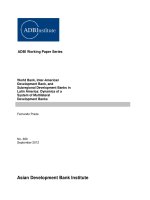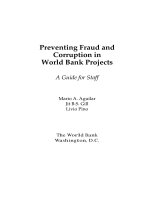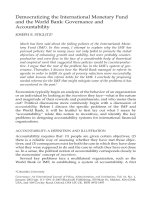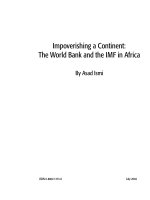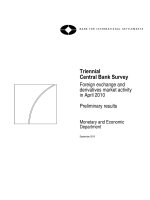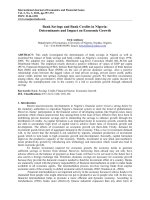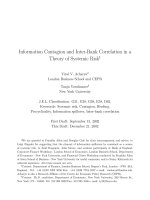World bank accountability in theory and in practice
Bạn đang xem bản rút gọn của tài liệu. Xem và tải ngay bản đầy đủ của tài liệu tại đây (5.61 MB, 655 trang )
andria naudé fourie
world bank
accountability
in theory and in practice
World Bank Accountability – in Theory and in Practice
World Bank Accountabilit y
– in Theory and in Practice
A n d r i a Nau d é Fo u r i e
Published, sold and distributed by Eleven International Publishing
P.O. Box 85576
2508 CG The Hague
The Netherlands
Tel.: +31 70 33 070 33
Fax: +31 70 33 070 30
e-mail:
www.elevenpub.com
Sold and distributed in USA and Canada
International Specialized Book Services
920 NE 58th Avenue, Suite 300
Portland, OR 97213-3786, USA
Tel.: 1-800-944-6190 (toll-free)
Fax: +1 503 280-8832
www.isbs.com
Eleven International Publishing is an imprint of Boom uitgevers Den Haag.
ISBN 978-94-6236-599-5
ISBN 978-94-6274-371-7 (E-book)
© 2016 Andria Naudé Fourie | Eleven International Publishing
Cover picture: © Curt Carnemark / World Bank, 'Group reading and writing, India',
IN005S05.
This publication is protected by international copyright law.
All rights reserved. No part of this publication may be reproduced, stored in a retrieval
system, or transmitted in any form or by any means, electronic, mechanical, photocopying,
recording or otherwise, without the prior permission of the publisher.
Printed in The Netherlands
To Mynie Barwise,
for teaching me about literature and life.
Acknowledgements
To my colleagues at the Erasmus School of Law, Erasmus University Rotterdam, our
intellectual interaction over the past decade has expanded my world of ideas beyond anything I would ever have imagined possible, while the friendship I’ve experienced while
being in the austere corridors and overflowing offices of the L-building has filled me with
lightness and a deep sense of grace. My sincerest gratitude to all of you.
It almost feels wrong to single out a few individuals, but I would also be remiss if I were
not to specifically thank Prof. Dr. Ellen Hey (we can walk, cook, drink wine, appreciate
art, music and nature – while also ‘solving’ many of the world’s problems, and unearthing
a few more in the process), Dr. Aleksandar Momirov (being able to quote extensively from
The West Wing should surely qualify as some academic credential), as well as Prof. Dr.
Sanne Taekema and Prof. Dr. Elaine Mak for helping me to shape the ideas contained in
this book.
Another person that has helped me to shape my ideas – almost entirely through our
virtual collaborations – is Prof. Dr. Daniel Bradlow. A heartfelt word of thanks – both to
him, and to whomever can truly claim to have created the Internet.
As always, however, the errors and shortcomings are my doing.
Thank you, also, to the previous two Deans of the Erasmus School of Law – Prof. Dr.
Maarten Kroeze and Prof. Dr. Susan Stoter – for agreeing to a virtual employment
arrangement that (and I feel I can safely generalize here) few academic administrators
would even have considered. De wereld is mijn (t)huis – indeed.
The research presented in this book would not have seen the light of day without a
dedicated team who have worked with me – most of the time, virtually, and in different
time zones – over a number of years. Thank you Paulo da Rosa, Jamaal Mohuddy and
Emelie Norling. And to Emelie in particular: thank you for supporting me every step of
the way and for teaching me that, if all else fails, there are always yoga and tea.
To Selma Hoedt and her team at Eleven Publishing/Boom Juridische Uitgevers – thank
you, in particular, for your immense patience. A few deadlines went swoooosh as they flew
by while you pretended, politely, not to have heard the noise.
Women continue to fret about whether they can have (or want) ‘it all’; and while I still
do not know what the ‘it’ or the ‘all’ supposedly entails, I am certain that I would not have
been able to do ‘anything’ – including writing this book – without the help of a growing
tribe of truly special women who are helping me to raise my daughters: Wilma, Mirelle,
Shani, Mindy, Sam, Rhodora, Alejandra, Ann and Darcie – thank you, for ‘everything.’
And to Cecile and Amelie, thank you for accepting that this is an important part of
who I am. I doubt whether you and the women of your generation will figure ‘it all’ out
vii
Acknowledgements
either, but I do hope that you will always remember that whatever ‘it all’ may be for you
is entirely up to you.
To Jac, finally, thank you for reformatting my footnotes. Fine; thank you for reformatting
it three times. Thank you for tolerating my absences and my absentmindedness. But above
all, thank you for thinking with me – about thinking and about doing.
viii
Table of Contents
Table of figures
xv
Introduction
1
1.1
1.2
1.2.1
1.3
2
2.1
2.2
2.3
Towards a Comprehensive Shared Understanding on World Bank
Accountability – in Theory and Practice
Aim and central arguments
Scope and approach
Inspection Panel practice as a window onto World Bank developmentlending operations
How this book is organized
Conceptual Models Facilitating Interdisciplinary Inquiry and Discourse
World Bank development-lending operations as situated in the
transnational development context
World Bank accountability conceived as an interdisciplinary, multidimensional and interdependent concept
Interactional normative processes, embedded in a resilient and adaptable community of interest
3
7
8
10
13
15
16
24
31
Part I Conceptualizing World Bank Accountability
3
3.1
3.1.1
3.1.2
3.1.3
3.1.4
3.1.5
3.2
‘To Whom’ Should the World Bank be Accountable? ‘Power Wielders’ and ‘Accountability Holders’
Prominent actors involved in World Bank development-lending operations
World Bank governance structure, management and staff
World Bank clients – borrowers, guarantors, project sponsors and
project implementing agencies
Co-financiers and their citizen-driven IAMs
Civil society organizations (‘local’ and ‘international’ NGOs)
Project-affected people (beneficiaries, adversely affected people and
‘Inspection Panel Requesters’)
World Bank accountability to internal and external accountability
holders
ix
47
47
48
58
62
66
71
75
Table of Contents
3.2.1
3.2.2
3.2.3
4
4.1
4.1.1
4.1.2
4.2
4.2.1
4.2.2
4.3
4.3.1
4.3.2
5
5.1
5.1.1
5.2
5.3
5.3.1
5.3.2
5.4
6
6.1
6.2
6.2.1
Internal accountability holders: World Bank member states and governance structure
External constituent groups: project-affected people, civil society and
broader public interest
Constituency groups competing for primacy
What Should the World Bank be Accountable ‘For’?
Four stages of development assistance
Development lending instruments
The development project cycle
Multiple interests, demands and expectations, resulting in complementary and competing institutional aims
Strategic repositioning and institutional reforms
Achieving ‘institutional equilibrium’: reconciling and prioritizing
competing institutional aims
World Bank and Borrower obligations
The formal division between Bank and Borrower obligations
Analysing a complex delineation
Assessing Accountability: Compliance with Normative Frameworks
The credit/loan agreement and the World Bank’s operational policy
framework
The ‘legal nature’ of the operational policy framework
National law (the Borrower’s constitutional system)
International law: Borrower and World Bank obligations
International legal obligations of borrower states
International legal obligations of the World Bank
International industry and/or professional standards and ‘best practice’
Assessing Accountability: Accountability Mechanisms and Competing Approaches to Compliance
Categorizing internal accountability mechanisms
Internal accountability mechanisms involved in the normative assessment of World Bank activities
Operations impact evaluation and quality assurance: IEG and OPCS
Vice Presidency
x
75
77
79
89
90
95
98
101
101
106
114
115
119
131
132
141
147
151
151
155
159
165
166
169
169
Table of Contents
6.2.2
6.2.3
6.2.4
6.3
6.3.1
6.3.2
6.3.3
6.3.4
7
7.1
7.1.1
7.1.2
7.1.3
7.1.4
7.1.5
7.1.6
7.2
7.2.1
7.2.2
Internal audit, institutional integrity and business ethics: IAD Vice
Presidency, INT Vice Presidency
Internal justice and conflict resolution: CRS
The Inspection Panel
What constitutes ‘compliance’ with the Bank’s operational policy
framework? Competing approaches to policy application and compliance assessment
Flexible versus consistent application – across projects and among
borrowers
Broader versus narrower ‘margins of discretion’
Restrictive versus expansive interpretation schemes
‘Process’ versus ‘substance’ – ‘compliance’ as comprising procedural
and substantive elements
Ensuring Accountability: Realizing and Enforcing Specific Outcomes,
Aligning Various Accountability Dimensions
Potential accountability outcomes arising in the context of Inspection
Panel practice
Recourse for project-affected people (‘voice’)
World Bank corrective actions and Borrower remedial actions
Redress for project-affected people
Strengthening the World Bank governance structure
Strengthening institutional performance: policy advice and institutional
learning
Normative development of the operational policy framework
Debating the Inspection Panel’s role and the value of its contribution
towards ensuring World Bank accountability
What is the role of the Inspection Panel?
What is the ‘real’ value of the Inspection Panel’s contribution?
171
172
173
192
196
198
200
201
209
210
213
216
222
227
229
235
239
239
245
Part II Operationalizing World Bank Accountability
Segment A Systemic Issues – Cutting Across Policy Areas
8
8.1
8.2
World Bank and Borrower Obligations – in Development Practice
Disagreement, misunderstanding or ambiguity concerning policy
obligations
Interfaces with the Borrower’s constitutional system
xi
267
267
272
Table of Contents
8.2.1
8.2.2
8.3
8.3.1
8.3.2
8.3.3
8.3.4
9
9.1
9.2
9.3
10
10.1
10.2
10.3
10.4
11
11.1
11.1.1
11.1.2
11.1.3
11.2
11.2.1
Project interfaces with the adoption, amendment and/or application
of national legislation
Project interfaces with similar Borrower activities, not financed by the
Bank
Borrower and/or project implementing agency capacity constraints
Managing risks associated with Borrower capacity constraints
Managing risks associated with project implementing agency capacity
constraints
Projects or project components related to strengthening Borrower
institutional capacity
‘Stepping in’ to mitigate risks related to Borrower capacity constraints
Achieving Equilibrium Among Institutional Aims: ‘Technical/Commercial’ versus ‘Non-technical/Non-commercial’ Project Components
Project modality, project design and project organization
Project financing structure, expenditure, implementation progress and
focus of supervision activities
Diverse interests within project areas, transparency about project prioritization and trade-off decisions
Decisions Determining Project Content and Scope – Affecting the
Content and Scope of World Bank Accountability
Description of project ‘modality’ and choice of lending vehicle
Delineating the ‘project area’ and ‘project area of influence’
Identifying and quantifying project-affected people
Interpretation of key phrases in operational policies and project design
documents
Access to Information and Participation in Decision-Making – at
the Project Level
‘Adequate’ project-information disclosure
Timing and frequency of project-information disclosure
Format and content of project-information material
The context of project-information disclosure activities
‘Meaningful’ participation or consultation
Timing and frequency of consultation
xii
273
279
285
286
290
293
299
303
304
314
319
329
329
336
345
352
361
361
362
364
372
375
376
Table of Contents
11.2.2
11.2.3
11.2.4
Format and content of consultation
Context in which consultation activities take place
Participants of consultation activities
381
386
389
Segment B Compliance Issues in Critical Operational Policy Areas
12
12.1
12.2
12.3
12.3.1
12.3.2
12.3.3
12.4
12.5
12.6
Involuntary Resettlement
Defining ‘involuntary resettlement’
Surveying project-affected communities
Determining compensation
Defining and differentiating ‘loss’
Cash versus in-kind replacement
Calculation of property replacement values
Resettlement sites, facilities and replacement housing
Income and livelihood restoration
Project-level grievance mechanisms
399
400
405
414
414
416
420
426
430
437
13
13.1
13.2
445
446
13.3.2
Indigenous Peoples
Defining and identifying ‘indigenous peoples’
Protecting indigenous peoples’ ‘rights and interests’: social assessments
and development plans
‘Stand-alone’ IP(D)Ps
Content and scope of IP(D)Ps and associated project documentation
Consultation with indigenous peoples
The meaning of ‘free, prior, informed consultation’ and ‘broad community support’
Consultation in ethnically complex communities
14
14.1
14.2
14.2.1
14.2.2
14.2.3
14.3
Environmental Assessment
Environmental screening (risk categorization)
The environmental assessment process
Environmental and social baseline data collection
Spatio-temporal scope of EAs and cumulative impact assessments
Substantive content of EAs
Consideration of design alternatives
487
487
494
495
501
511
515
15
15.1
Project Supervision
Identifying risks and potential issues throughout the project cycle
527
528
13.2.1
13.2.2
13.3
13.3.1
xiii
454
456
464
470
470
476
Table of Contents
15.2
15.2.1
15.2.2
15.3
15.3.1
15.3.2
15.3.3
Addressing issues through corrective and/or remedial actions
Initiate actions and/or follow-up on the implementation of actions
‘Going further’ – but how far?
‘Robust’ project supervision systems
Location, timing and frequency of supervision activities
Resourcing of supervision missions
Content and context of supervision activities
532
532
539
552
552
555
560
Conclusion
16
16.1
16.1.1
16.1.2
16.1.3
16.2
16.2.1
A Shared Commitment, a Shared Goal – and a Shared Surface
World Bank Accountability as a Complex Societal Issue – Requiring
an Interactional, Collaborative and Integrative Approach
Conflicting, competing or contradictory relationships
Causal, complementary or interdependent relationships
A dual and mutually constitutive social structure
A shared surfaced offered by norm creation, norm application and
norm enforcement, embedded in a community of practice
Strengthening the resilience and adaptability of the community of
practice
569
571
571
572
573
575
577
Abbreviations, Acronyms and Terminology Commonly Used in World Bank
Development-lending Operations
589
References
601
Index
625
xiv
Table of figures
Figure 1: A Transnational Regulatory Governance ‘Space’ Marked by
Pluralism and Dynamic Complexity
Figure 2: Interdependent Dimensions of World Bank Accountability
Figure 3: The ‘Continuum of Legality’
Figure 4: World Bank Governance and Management Structure
Figure 5: Four Stages of Development Assistance
Figure 6: The World Bank Project Cycle
Figure 7: World Bank Development-lending Operations: Performance
Areas and Indicators
Figure 8: Accountability for Performance and Harm
Figure 9: Expounding World Bank and Borrower Obligations
Figure 10: World Bank Development-Lending Operations and Intersecting
Normative Frameworks
Figure 11: Competing Approaches to Operational Policy Application and
Compliance Assessment
Figure 12: Realizing and Enforcing Interdependent Accountability Outcomes
Figure 13: The Inspection Panel’s ‘Dual Accountability Mandate’ –
Reflecting Competing Interests, Demands, Expectations and Conceptions
about Accountability Outcomes
Figure 14: An Interpretative Scheme that Enables the Effective Execution
of a Dual Accountability Mandate
xv
20
28
34
49
94
99
107
110
120
133
195
212
242
587
Introduction
“As Yogi Berra said: ‘In theory there is no difference between theory and practice. In
practice there is.’”
– N. Taleb, Antifragile: Things that Gain from Disorder (2012) –
1
Towards a Comprehensive Shared
Understanding on World Bank
Accountability – in Theory and Practice
Why another book about World Bank accountability?
Much has certainly been said about the need to strengthen, enhance, expand, measure,
assess, ensure or realize the accountability of international financial institutions such as
the World Bank,1 whereas much thought has gone into what such accountability should
entail – as reflected in a vast body of literature that cuts across various disciplines and
domains of practice.2
Much has also been done to translate theory into practice. Over the past few decades,
for instance, the World Bank has implemented various reforms to its governance and
management structures;3 the Bank has increased the transparency of its operations by
means of a far-reaching policy on Access to Information and has also adopted various
measures aimed at ensuring public participation in the decision-making processes concerning Bank-financed development projects.4 The World Bank has developed and applied an
operational policy framework that is aimed at guiding and, in some respects, regulating
all aspects of the Bank’s development-lending operations, including the management of
economic, social and environmental risks.5 And, finally, the World Bank has established
a range of internal ‘accountability mechanisms’ that are mandated to contribute to the
enforcement of the operational policy framework – including mechanisms that are ‘citizen-
1
2
3
4
5
Hereinafter, ‘World Bank’ or ‘Bank’, referring to the International Bank for Reconstruction and Development
(IBRD), and the International Development Association (IDA). On international financial institutions (IFIs)
and their operations, as situated in the international legal system, see in general Bradlow & Hunter (Eds.)
(2010).
See e.g., Von Bogdandy et al. (Eds.) (2010); Bradlow & Grossman (1995); Clark (2002); Clark et al. (Eds.)
(2003); Coicaud & Heiskanen (Eds.) (2001); Danaher (Ed.) (1999); Darrow (2006); Hernández Uriz (2001);
Horta (2002); Kingsbury et al. (2005); Miller-Adams (1999); Nanda (2004-2005); Reinisch (2001); Reinisch
(2008); Shihata (1992-1993); Shihata (1988-1989); Shihata (2000); Van Putten (2008); Wellens (2002); Zweifel
(2006); ILA (1998); ILA (2004); Head (2003-2004); Fox (1997); Bradlow (1996); Nanwani (2008); Cissé et
al. (Eds.) (2012); Wouters et al. (Eds.); Van Putten (2008), pp. 32-65; and Raffer (2004).
See e.g., Phillips (2009); and Bradlow in Cissé et al. (Eds.) (2012), e-Book. Also see section 3.1.1.
See e.g., Miller-Adams (1999); Hunter in Bradlow & Hunter (Eds.) (2010); and see Independent Accountability
Mechanisms Network (2012), pp. 4-5. See e.g., the discussion in Ch. 11.
See e.g., Bradlow & Chapman (2011); Freestone (2003); Kingsbury (1999); and Bradlow & Naudé Fourie
(2013). Also see section 5.1.
3
World Bank Accountability – in Theory and in Practice
driven’ because their procedures can be triggered from outside the institution, by individuals.6
Indeed, it is on the basis of such efforts that we have been able to reach consensus that
international financial institutions (‘IFIs’) such as the World Bank have a duty of
accountability,7 and it is through the interaction between theory and practice that we have
started to draw the contours of this duty, while contemplating the implications thereof.
That being said, we are yet to arrive at the point where we can state that we have reached
a comprehensive “shared understanding”8 on what the accountability of international
financial institutions means – in theory and in practice.
For some, the World Bank’s efforts to address concerns about its accountability have
not gone far enough. They question, for instance, the content and scope of operational
policies aimed at managing economic, social and environmental risks;9 or, are critical of
the effectiveness of internal accountability mechanisms such as the Inspection Panel.10
They argue that legal normativity has a distinct and crucial role to play in conceptualizing
and operationalizing the World Bank and IFI accountability, but their arguments are
influenced by the continued jurisprudential debate about the nature and purpose of
international law, and how it operates.11
For others, the World Bank’s efforts to address these criticisms have gone too far. They
argue, for example, that the Bank’s prolonged focus on accountability has come at the cost
of institutional effectiveness and efficiency; and that the Bank’s ‘norm-based’ approach,
which involves the application and enforcement of the Bank’s operational policy framework
across its development operations, has made it too cumbersome and too expensive to ‘do
6
7
See e.g., the discussion in section 6.2.
As reflected, e.g., in the conceptual work of the International Law Association – see ILA (1998) and ILA
(2004).
8 Conklin (2005), p. 1.
9 See e.g., MacKay (2005) and MacKay in Bradlow & Hunter (Eds.) (2010) (commenting on the adequacy of
the Bank’s policy on Indigenous Peoples). For criticism about the World Bank’s latest safeguard policy review
see e.g., Note, a safeguard policy review has been initiated in 2012 and was ongoing at the time of writing
(October 2015); for more on this review, see note 28, Ch. 5.
10 See e.g., Circi (2006); Orakhelashvili (2005); Nurmukhametova (2006); Ananthanarayanan (2004); and
Carrasco & Guernsey (2008).
11 For an overview of the major arguments in these debates, see e.g., Kingsbury (1997-1998), pp. 348-367;
Scobbie in Evans (2006), pp. 83-156; and see Chinkin in Shelton (Ed.) (2000), pp. 21-42. Chinkin notes (at
p. 21): “Current debates about the forms and functions of international law-making are a continuation of
long-standing tensions between those who assert the paramountcy of state consent and those who urge
limitations on state action in favour of international regulation”. In this regard, also see Higgins (1994), who
argues (at p. 17) that the continued jurisprudential debate “is an admission of uncertainty at the heart of the
international legal system” – which means that “until the answers to the question of identification, of
provenance of norms, are more settled, […] we do not have the tools for rendering more certain the content
of particular norms […].”
4
1
Towards a Comprehensive Shared Understanding on World Bank
Accountability – in Theory and Practice
business with the Bank’, especially compared with new and newly emerging competitors
in the field of international development finance.12
The context in which the discourse on World Bank and IFI accountability is situated,
moreover, has been undergoing significant change in some respects, while remaining
largely static in others.
Since World Bank accountability first became the “catchcry of officials, scholars and
activists” during the 1990s,13 the “international financial and economic system” has been
marked by a “growing complexity”, which, in combination with a “deepening understanding
of the complexities of poverty and development” have “changed the ways in which multilateral development banks (MDBs) operate.”14
Moreover, ongoing shifts in global economic and political power have meant that
multilateral development institutions increasingly have to “compete or cooperate with the
private sector and other official creditors in funding projects in their member states.”15
“Middle-income countries such as Brazil and India can now borrow cheaply on international
capital markets”,16 for instance, whereas China – long a prominent World Bank borrower
– has emerged as an influential actor in the field of development finance.17
12 S. Donnan, ‘World Bank: Stress Test’, Financial Times, April 16, 2015, available at www.ft.com: “Few doubt
the bank is in need of change. David Dollar, a former US Treasury official who spent 20 years at the bank,
says it has long had a plodding bureaucracy that at times has caused some borrowing nations to shy away.
He cites an Indian official who once told him: “Mr Dollar, the combination of our bureaucracy and your
bureaucracy is deadly.” On new competitors in the field of development finance, see e.g., note 17, Ch. 1; but
also see note 46, Ch. 3.
13 Woods (2001), p. 83.
14 Bradlow in Cissé et al. (Eds.) (2012), e-Book. On the effects of these changes, also see the discussion in sections
2.1 & 4.1. Note, multilateral development banks (MDBs) are a specific category within the broader group of
international financial institutions – see Bradlow in Bradlow & Hunter (Eds.) (2010), pp. 2-5.
15 Bradlow in Cissé et al. (Eds.) (2012), e-Book.
16 Id.
17 See e.g., G. Parker & A. Beattie, ‘EIB Accuses China of Unscrupulous Loans’, Financial Times, 28 November
2006, available at www.ft.com: “The world’s development banks may have to water down the social and
environmental conditions they attach to loans in Africa and elsewhere because they are being undercut by
less scrupulous Chinese lenders, the European Investment Bank said on Tuesday. Philippe Maystadt, the
EIB’s president, said banks like his were operating in competition with Chinese lenders anxious to extend
Beijing’s influence across the world. ‘The competition of the Chinese banks is clear,’ said Mr Maystadt, whose
European Union-backed bank is the world’s biggest multilateral lender. ‘They don’t bother about social or
human rights conditions’.” Also see S. Lindemann, ‘China’s Development Finance to Africa – Risks and
Opportunities for DAC Donors’, KFW DEVELOPMENT RESEARCH, Focus on Development, No. 7,
16 September 2013, available at: Also see Miller-Adams
(1999), pp. 127-128: “In many ways China, by virtue of its size, is more important to the Bank than the Bank
is to China. Nancy Alexander, a long-time observer of the Bank, recounts the story of a junior Bank official
on a mission to China who asked his senior colleague whether the Bank was pressuring China to permit
greater levels of grassroots participation in development. “The senior official replied, ‘We are fortunate that
China is allowing the World Bank to participate in its development efforts’.” The author references N.C.
Alexander (1998), ‘The World Bank’s New Strategic Alliances’, Draft Paper, Development Bank Watchers’
Project, Silver Spring Md.: Bread for the World Institute.
5
World Bank Accountability – in Theory and in Practice
As a consequence of these changes, the World Bank’s status as the world’s ‘premier
lending institution’ has increasingly come under pressure – to the extent, as some commentators have come to argue, that the World Bank is facing “[a] creeping irrelevance”,
and that the Bank’s most recent wave of institutional changes (spearheaded by current
World Bank Group President, Jim Yong Kim) is a necessity to counteract the Bank’s
“journey to the sidelines,” or to prevent its “slide into insignificance.”18
But for all the talk about change, several aspects that form an important part of the
discourse on accountability have not changed – or, at least, have not changed enough.
Development projects such as those (co-)financed by the World Bank and other development-lending institutions continue to involve a wide range of economic, social and environmental risks that require diligent management. And, in instances where these risks do
materialize, they continue to result in material adverse effects that might be irreversible
or costly to address – and, therefore, impede the realization of sustainable development.19
In addition, the international legal system remains ill equipped to address accountability
issues, in particular from the perspective of ‘project-affected people’ who are not in a
contractual relationship with development-lending institutions. Project-affected people
adversely affected by development projects (co-)financed by multilateral development
institutions remain without the possibility of legal recourse against these institutions, due
to the (qualified) immunity of international organizations before domestic courts20 and
as a result of the limited standing (both of individuals and international institutions) before
international judicial courts and tribunals.21 And while it is generally acknowledged that
MDBs, as subjects of the international legal order, have international legal obligations, the
content and scope of these obligations remain a matter of debate, particularly since state
actors remain the only parties to prominent international treaties governing international
environmental and human rights law.22
18 R. Harding, ‘World Bank: Man on a Mission’, Financial Times, 7 April 2014, available at www.ft.com.
19 On the conceptualization of sustainable development as comprising social, economic and environmental
areas (‘pillars’), see e.g., Birnie & Boyle (2002), pp. 44-47; Magraw & Hawke in Bodansky et al. (Eds.) (2007),
pp. 613-638. Also see Freestone’s remarks at note 27, Ch. 5.
20 See e.g., Reinisch (2008); Schermers & Blokker (2003), §§ 1610-1612; Reinisch & Wurm in Bradlow & Hunter
(Eds.) (2010), pp. 103-136; Herz in Bradlow & Hunter (Eds.) (2010), pp. 137-166; and Van Putten (2008),
pp. 35-36. On the immunity of international organizations as a “structural” impediment to the implementation
of an international legal regime on the responsibility of international organizations, see e.g., Crawford (2007),
pp. 5-6. Also see the World Bank’s Articles of Agreement, Article VII.
21 See e.g., Klabbers (2013), pp. 140-154; Schermers & Blokker (2003), §§ 686-482; and Crawford (2007), pp. 56.
22 See e.g., Bradlow in Bradlow & Hunter (Eds.) 2010, pp. 29-30 and see pp. 338-389. On the issue of the World
Bank’s international human rights obligations, see e.g., Darrow (2006); Van Putten (2008), pp. 39-43;
McInerney-Lankford in Bradlow & Hunter (Eds.) (2010), pp. 239-286; and De Schutter in Wouters et al.
(Eds.) (2010), pp. 51-128. On the ‘gaps’ in the international legal system and their effects on the accountability
of international organizations, also see Bradlow & Hunter at note 178, Ch. 3. Also see the discussion in sections
5.1.1 & 5.3.2.
6
1
Towards a Comprehensive Shared Understanding on World Bank
Accountability – in Theory and Practice
In fact, it is those aspects of the discourse that have remained largely static, which best
explain why the accountability of international financial institutions such as the World
Bank remains a “normatively desirable” outcome,23 and why it continues to be a topic of
significance – even as the discourse has to address the changes occurring in the underlying
context.
1.1
Aim and central arguments
With these arguments serving as its point of departure, this book aims to contribute towards
the progressive development of a comprehensive shared understanding of what the
accountability of international financial institutions such as the World Bank means conceptually (specifically at lower levels of abstraction that have to incorporate cumulative
degrees of detail and complexity) and operationally (specifically including the perspective
of individuals affected by development-lending operations).
Such a comprehensive shared understanding has to reflect the wide array of diverse
interests, demands, expectations and underlying conceptions surrounding the multidimensional and interdisciplinary concept of ‘accountability’.24 It also has to address the multiple
relationships (some competing or contradictory; others complementary, mutually reinforcing or interdependent) that drive the decisions, actions and behaviours of a wide range of
participants.
The analysis presented here therefore aims to expound the pluralism and dynamic
complexity of the particular context in which World Bank development-lending operations
are situated – that is: a transnational regulatory governance context, which involves various
levels of governance, different types of actors (participating in various capacities), different
legal systems (international, regional, national, sub-national or local), as well as different
forms of normativity (legal and social, or non-legal).25
Furthermore, the progressive development of a comprehensive shared understanding
on accountability requires the continuous interaction of the participants to this discourse,
which can be facilitated by the processes of norm creation, norm application and norm
enforcement underlying the World Bank’s development-lending operations.26
The analysis employs a conception of social and legal normativity that is based in
constructivist and interactional thinking,27 which can yield insights as to nature and purpose
23 Rubenstein (2007), p. 620. The author sets out various reasons “why accountability might be normatively
desirable in a given context.” (Id.)
24 See section 2.2.
25 See section 2.1.
26 See section 2.3.
27 See in general Brunnée & Toope (2010).
7
World Bank Accountability – in Theory and in Practice
of (social and legal) normativity, as well as the mechanism through which it operates in
transnational regulatory governance contexts.
1.2
Scope and approach
While this book focuses on World Bank accountability, the analysis presented here is of
broader significance for international financial institutions with similar institutional
shareholders and comparable development-lending operations.28 Moreover, the analysis
might also be of interest to other types of international organizations. “Given that the IFIs
are facing complex and diverse economic, financial, political, social, and environmental
issues,” as Bradlow comments,
it can be seen that they are on the cutting edge of difficult and important
international law issues. How they respond to these issues will set precedents
that have the potential to influence other international actors and to guide their
own further responses to these issues.29
The scope of the analysis is specifically limited to the World Bank’s development-lending
operations, which, as defined here, are comprised of the actors, governance and management
structures, the core activities and processes, as well as the intersecting normative systems30
involved in the design, planning, preparation, appraisal, approval, financing, implementation
and closure of development projects that are either financed or co-financed by the World
Bank.31
Finally, the World Bank’s development-lending operations are analyzed primarily from
the perspective offered by the Bank’s citizen-driven accountability mechanism, the
28 See Bissell & Nanwani (2009), p. 26, commenting that IFIs, despite their differences, “have similar classes
of shareholders […] and […] the same donor countries championing accountability mechanisms,” notably,
“the United States and several European countries including the United Kingdom, Switzerland, Netherlands,
and Germany.” Also see Head (2003-2004), pp. 244-249, who notes that the MDBs finance similar projects,
with similar approaches (e.g., they operate on a “reimbursement basis, so that funds are transferred only
against expenditures as they are actually incurred”). In addition, “most of the MDBs also engage in some
degree in “policy-based” lending by which funds are provided to support (and in return for) the adoption
by borrower governments of certain economic and financial policies favoured by the MDBs.” (Id.) Furthermore, MDBs share a number of common criticisms – including their “unaccountability and democracy
deficit.” (Id., at p. 299.)
29 See Bradlow in Bradlow & Hunter (Eds.) (2010), pp. 25-30.
30 For a definition of normative systems, see section 2.3.
31 Note: the scope of this book excludes the project identification, closure and post-implementation stages, in
line with the institutional mandate of the Inspection Panel – as discussed e.g., in section 4.1.2.
8

